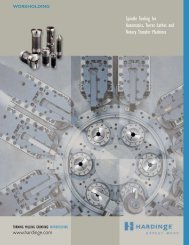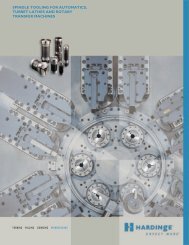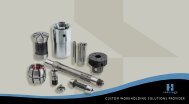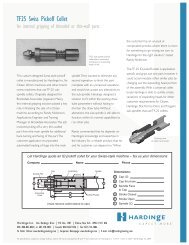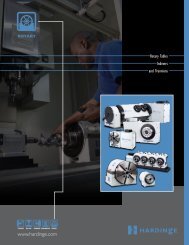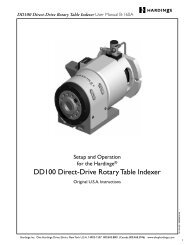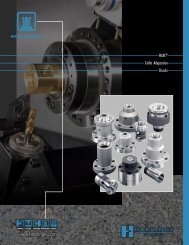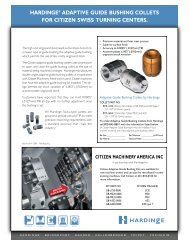Create successful ePaper yourself
Turn your PDF publications into a flip-book with our unique Google optimized e-Paper software.
<strong>Sure</strong>-Grip ® <strong>Power</strong> <strong>Chuck</strong> Safety and Technical Manual B-87Z<br />
Draw Bar/Tube Force<br />
The draw bar/tube force has a direct relationship to the gripping force of the chuck being used. Each different size, style<br />
(lever/wedge/compensated) and manufacturer will have different gripping force using the same draw bar/tube force. These<br />
differences are related to the chuck's lever ratio, mechanical efficiency, mass and flexibility of the workpiece. The values for<br />
draw bar force can be obtained from the graphs shown on the next page. The working pressure required on the<br />
Hardinge ® operating cylinder is shown after those graphs.<br />
FIND:<br />
Turning Example Calculation:<br />
Given:<br />
Material ...................................................................Low Alloy Steel<br />
Workpiece diameter ...........................................d SP = 75 mm (2.953")<br />
Diameter to be machined ..................................d Z = 50 mm ( 1.968")<br />
Feedrate .................................................................Sr = 0.20 mm (.0079")/ Rev<br />
Depth of cut ..........................................................t = 2 mm (.078")<br />
Distance between start of<br />
cut and clamping points ......................................Lz = 50 mm (1.968")<br />
Speed .......................................................................N = 2000 RPM<br />
<strong>Chuck</strong>ing length ....................................................Lsp = 20 mm ( .790")<br />
Actuating cylinder ................................................Hardinge (QUEST ® 6/42)<br />
<strong>Chuck</strong> Specifications:<br />
Hardinge <strong>Sure</strong>-Grip ® 6" chuck<br />
– 3 jaw<br />
– External gripping<br />
– Standard height pointed soft jaws<br />
– Located against stop on chuck face<br />
1. Required gripping force........................"Fsp Z" = Total gripping force required without the effect of angular speed<br />
2. Initial gripping force .............................."Fsp Q" = Total initial gripping force with stationary chuck<br />
3. Draw bar pull force<br />
4. Pressure required at the cylinder<br />
SOLUTION: All formulas are calculated with metric values<br />
1. Main Cutting Force formula: Fs = (Sr x t) x Kc ( Sr x t from table 1) (Kc from table 2)<br />
Known: Sr = 0.20 mm feed rate Fs = 0.2 x 2 x 3400<br />
t = 2 mm depth of cut<br />
Kc = 3400N/mm<br />
Fs = 0.4 x 3400<br />
2 (table 2)<br />
Fs = 1360N (306 lbs)<br />
2. Required Gripping Force: (formula 1) Fspz = Fs x Sz x dz µ sp dsp Known: Fs = 1360N (from above formula) Fspz = ([1360 x 2] ÷ .15) x 0.6666<br />
Sz = 2 (length factor from table 5 Fspz = (2720 ÷ .15) x 0.6666<br />
[Lz = 50mm, Lsp = 20mm])<br />
µ sp = 0.15 (chucking coefficient table 2)<br />
Fspz = (18133.3) x 0.6666<br />
dZ ÷ dSP = 0.6666 (chucking ratio from table 4<br />
[dZ = 50 mm, dSP = 75 mm])<br />
Fspz = 12,077N (2717 lbs)<br />
3. Find Centrifugal Force "Fc" of the top jaws. Fc = 3,111N (700 lbs)<br />
Use the graph on the next page for "Centrifugal Force<br />
of Jaws Corresponding to Spindle RPM (2,000 RPM) for<br />
the 6" <strong>Sure</strong>-Grip ® <strong>Chuck</strong>. (Calculation continued after graphs)<br />
Hardinge Inc. One Hardinge Drive, Elmira, New York U.S.A. 14902-1507 800.843.8801 www.hardingetooling.com<br />
111



